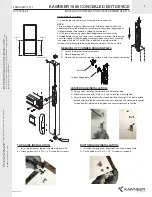
Warranty and Warning Information
Elevator Restriction System Installation and Operation Manual
43
8.
Insufficient Time.
There may be circumstances when a Mircom System
will operate as intended, yet the occupants will not be protected from the
emergency due to their inability to respond to the warnings in a timely
manner. If the system is monitored, the response may not occur in time
enough to protect the occupants or their belongings.
9.
Carelessness or Safety Hazards.
Moreover, smoke detectors may not
provide timely warning of fires caused by carelessness or safety hazards
such as smoking in bed, violent explosions, escaping gas, improper
storage of flammable materials, overloaded electrical circuits or children
playing with matches or arson.
10.
Power Failure.
Some Mircom System
components require adequate
electrical power supply to operate. Examples include: smoke detectors,
beacons, HVAC, and lighting controllers. If a device operates only by AC
power, any interruption, however brief, will render that device inoperative
while it does not have power. Power interruptions of any length are often
accompanied by voltage fluctuations which may damage Mircom
Systems or other electronic equipment. After a power interruption has
occurred, immediately conduct a complete system test to ensure that the
system operates as intended.
11.
Battery Failure.
If the Mircom System or any device connected to the
system operates from batteries it is possible for the batteries to fail. Even
if the batteries have not failed, they must be fully charged, in good
condition, and installed correctly. Some Mircom Systems use replaceable
batteries, which have a limited life-span. The expected battery life is
variable and in part dependent on the device environment, usage and type.
Ambient conditions such as high humidity, high or low temperatures, or
large temperature fluctuations may reduce the expected battery life.
Moreover, some Mircom Systems do not have a battery monitor that
would alert the user in the event that the battery is nearing its end of life.
Regular testing and replacements are vital for ensuring that the batteries
function as expected, whether or not a device has a low-battery monitor.
12.
Physical Obstructions.
Motion sensors that are part of a Mircom System
must be kept clear of any obstacles which impede the sensors’ ability to
detect movement. Signals being communicated by a Mircom System may
not reach the receiver if an item (such as metal, water, or concrete) is
placed on or near the radio path. Deliberate jamming or other inadvertent
radio signal interference can also negatively affect system operation.
13.
Wireless Devices Placement Proximity.
Moreover all wireless devices
must be a minimum and maximum distance away from large metal
objects, such as refrigerators. You are required to consult the specific
Mircom System manual and application guide for any maximum
distances required between devices and suggested placement of wireless
devices for optimal functioning.
14.
Failure to Trigger Sensors.
Moreover, Mircom Systems may fail to
operate as intended if motion, heat, or smoke sensors are not triggered.







































